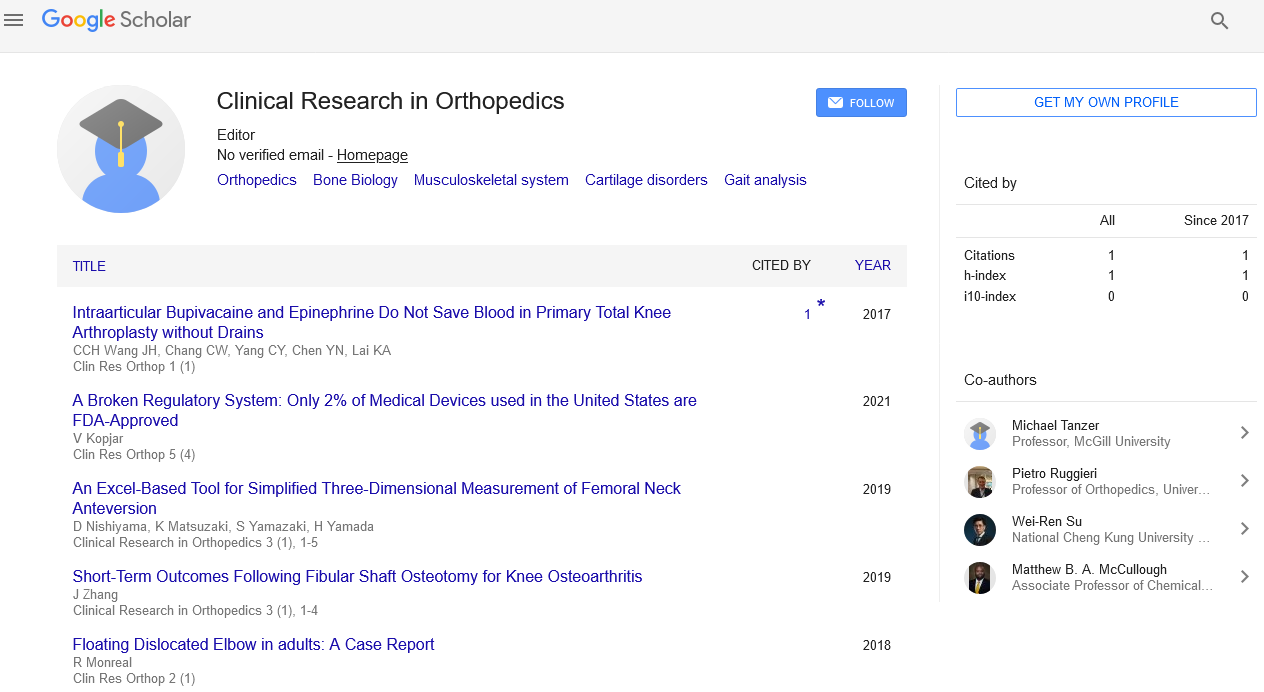Editorial, Clin Res Orthop Vol: 5 Issue: 4
A Broken Regulatory System: Only 2% of Medical Devices used in the United States are FDA-Approved
Veljko Kopjar*
Director of Clinical Development, Clinipace Worldwide, Inc. North Carolina, USA
*Corresponding author: Velijko Kopjar,Director of Clinical Development,Clinipace Worldwide, Inc. North Carolina, USA, Tel: 1 2069495364;
E-mail: kopjar@yahoo.com
Received date: May 14, 2021; Accepted date: May 29, 2021; Published date: June 06, 2021
Abstract
When most people think of medical devices that are legally marketed in the United States and implanted or otherwise used by trained and licensed surgeons, they are very likely thinking of FDAApproved medical devices. FDA Approval incorporates rigorous preclinical research such as: cadaver, animal, mechanical, materials and stress testing followed by human subject trials that are aimed at proving that a device is safe and effective. The trials may include a pivotal trial preceded by one or more pilot studies, and an adequate number of months for clinical follow-up. Many devices (e.g., hipreplacement systems) usually require at least 24 months’ follow-up. In order for a company to pursue this pathway, it must first obtain an Investigational Device Exemption (IDE) which allows it to use the product in an investigational setting. Obtaining an IDE usually involves several rounds of discussions with the FDA during which the study protocol, statistical approaches and safety considerations are discussed. The results of the IDE trial are submitted by the company to the FDA as part of a 510 k de novo or a Premarket Approval (PMA) application. The FDA has 180 days to review the application and confirm or deny the company to begin marketing its device [1]. Overall, this is a fairly rigorous approach that can take up to seven years depending on the type of device and the required testing [2]. One may think of it as the equivalent of the approval process for new drugs. Before a drug can be marketed, extensive pre-clinical testing is needed. Successful molecules may be moved into Phase 1 trials, followed by Phase 2 trials and eventually one or more Phase 3 trials that may or may not result in FDA approval. Even though the FDA device approval process is less cumbersome than the process for drug approvals, it still provides a high level of confidence that a device is safe and effective for its indication(s).
Introduction
When most people think of medical devices that are legally marketed in the United States and implanted or otherwise used by trained and licensed surgeons, they are very likely thinking of FDAApproved medical devices. FDA Approval incorporates rigorous preclinical research such as: cadaver, animal, mechanical, materials and stress testing followed by human subject trials that are aimed at proving that a device is safe and effective. The trials may include a pivotal trial preceded by one or more pilot studies, and an adequate number of months for clinical follow-up. Many devices (e.g., hipreplacement systems) usually require at least 24 months’ follow-up. In order for a company to pursue this pathway, it must first obtain an Investigational Device Exemption (IDE) which allows it to use the product in an investigational setting. Obtaining an IDE usually involves several rounds of discussions with the FDA during which the study protocol, statistical approaches and safety considerations are discussed. The results of the IDE trial are submitted by the company to the FDA as part of a 510 k de novo or a Premarket Approval (PMA) application. The FDA has 180 days to review the application and confirm or deny the company to begin marketing its device [1]. Overall, this is a fairly rigorous approach that can take up to seven years depending on the type of device and the required testing [2]. One may think of it as the equivalent of the approval process for new drugs. Before a drug can be marketed, extensive pre-clinical testing is needed. Successful molecules may be moved into Phase 1 trials, followed by Phase 2 trials and eventually one or more Phase 3 trials that may or may not result in FDA approval. Even though the FDA device approval process is less cumbersome than the process for drug approvals, it still provides a high level of confidence that a device is safe and effective for its indication(s).
 Spanish
Spanish  Chinese
Chinese  Russian
Russian  German
German  French
French  Japanese
Japanese  Portuguese
Portuguese  Hindi
Hindi 